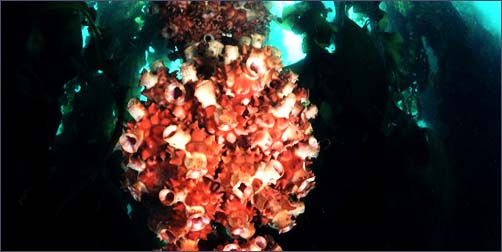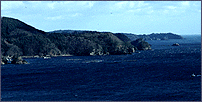
|
No. 19 Maboya Ascidian Cultivation in Onagawa, the Sanriku Coast. |

|
No. 19 Maboya Ascidian Cultivation in Onagawa, the Sanriku Coast. |

|
|
|
Cultivating Maboya Ascidians (Halocynthia roretzi). The Maboya were full of energy and life in a dark sea whose surface was covered with seaweed. Their figures teemed with life. |
|
|
Do you like ascidian? "Well... but the smell....", I can hear a voice say. It does have a peculiar taste but I like ascidian very much. Fresh ascidian just taken from the sea is delicious, crispy, and sweet. It is fabulous.
About 300 varieties of ascidian have been identified in the waters around Japan. The Maboya is a rare variety that is edible. When diving in the seas effected by a cold current such as the Sanriku Coast and Senday Bay, you can easily find more ascidian than you care to see. Three here and four there, Maboya ascidians each the size of a softball can be found in the reefs. The Hoya is type of protochordata. When it is newly born, it is shaped like a tadpole. A spine can be seen in the tail but as it grows, it undergoes metamorphosis and the spine disappears. In this period, the Hoya moves around like an animal. After this phase, it becomes rooted like a plant on the stable sea bottom and sucks in the seawater from which it takes nourishment and grows. The Maboya that can be seen on the seabed has two pipes shaped like an open end of a trumpet, one for sucking in and one for spewing out seawater. They are feeding with gusto. Depending on your perspective, it can look like a man's heart. In the cold current where the colors are sparse, their warm orange body puts the diver at ease. They are gentle creatures. The cultivation of the Maboya centers in the Sanriku area. The Maboya larva are grown in a water tank and then set atop oysters or other shells and sunk into the sea. The Maboya thereafter, literally grow in clusters. I came to want to see the Maboya globes, and I asked a fisherman in a town north of Kinkazan in Onagawa, to let me dive under a cultivation raft. As I dived and plowed my way through the seaweed being cultivated, the target of my search, the Maboya, came into view. About 50-60 Maboya under cultivation formed a sphere about 50 centimeters in diameter. There were five spheres for each rope that was hanging down. The seaweed hung down from the surface forming a pleasant sunshade that created a favorable shady environment for the Maboya. The globes, by the way, were truly beautiful. They heartily take in nourishment from the Oyashiro Current and they are full of life. When I pressed my face close to the Maboya and tried to peer into the interior of its body, it spewed brown things like a rope from its drainpipe. It was its stool. What terrible manners it has. It seems that they have an organ that detects light near its drainpipe and its suction pipe. It reacted to my closing in, shrunk back, and spewed out the debris of the seawater. I felt like it was an animal after all. As I was looking at them shining in orange, I felt as if I could hear the sound of trumpets from their splendid expanded pipes. When men see the cold current, the color of lead, surging in, they shiver and feel bolstered that they live an existence far removed from it.  We exist, however, with the support of the marine creatures nurtured by this cold current. It cannot be true that the cultivated Maboya, which bloom so beautifully under the shadow of the seaweed, exist solely to be eaten by man. We should not forget the beauty of their form and their delicate taste. We exist, however, with the support of the marine creatures nurtured by this cold current. It cannot be true that the cultivated Maboya, which bloom so beautifully under the shadow of the seaweed, exist solely to be eaten by man. We should not forget the beauty of their form and their delicate taste.
|
|
The view from Onagawa port. The rich Oyashio Current nurtures many creatures. |
|
|